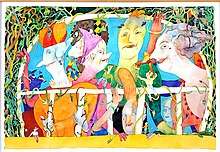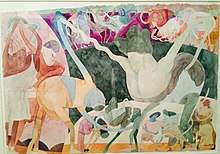Gladys Nilsson
Gladys M. Nilsson (born May 6, 1940) is an American artist, one of the original Hairy Who Chicago Imagists, a group in the 1960s and 1970s who turned to representational art. Her paintings "set forth a surreal mixture of fantasy and domesticity in a continuous parade of chaotic images."[1] She is married to fellow-artist and Hairy Who member Jim Nutt.[2]
Gladys Nilsson | |
|---|---|
| Born | May 6, 1940 Chicago, Illinois |
| Nationality | American |
| Education | Art Institute of Chicago |
| Known for | Painting |
| Movement | Chicago Imagism |
| Spouse(s) | Jim Nutt |
Biography
Gladys Nilsson was born to Swedish immigrant parents. Her father was a factory worker for Sunbeam and her mother a waitress.[3] She grew up on the north side of Chicago and attended Lake View High School, while also attending extracurricular drawing classes. Against her parents' blue collar sensibilities, she attended the School of the Art Institute of Chicago, where she met her future husband, fellow student Jim Nutt.[3] Nilsson and Nutt married in July 1961, and their son, Claude, was born in 1962.[3] Although Nilsson originally painted with oil paints, she switched to watercolors when pregnant in order to avoid the hazards of turpentine.[3] She initially found it difficult to strike a balance between motherhood and her career in painting, though she states that she never considered giving up painting. [citation needed]
In 1963, Nilsson and Nutt were introduced to School of the Art Institute of Chicago art history professor Whitney Halstead, who became a teacher, mentor, and friend.[3] He introduced them in turn to Don Baum, exhibition director at the Hyde Park Art Center in Chicago.[3] In 1964 Nilsson and Nutt became youth instructors at the Hyde Park Art Center.[3]
Artistic Style
Gladys Nilsson's influences were far ranging and included German Expressionism, 15th Century Italian painting, Egyptian tomb murals, Cubism, and, more specifically, Whitney Halstead, Kathleen Blackshear, James Ensor, George Grosz, Paul Klee, Georges Seurat, John Marin, and Charles Burchfield. The result was a style that bordered on surrealism and pop, fantasy and cartoon. She took the human figure as her main subject, magnifying, multiplying, and distorting these figures as she saw fit.
The Hairy Who Years
In 1964, Jim Nutt and Gladys Nilsson began to teach children's classes at the Hyde Park Art Center in Chicago. They and James Falconer approached the center's exhibitions director, Don Baum, with the idea of a group show consisting of the three of them and Art Green and Suellen Rocca. Baum agreed, and also suggested they include Karl Wirsum.[3] The name of the group show, "Hairy Who?", became the name of the group. It was coined by Karl Wirsum as a reference to WFMT art critic Harry Bouras.[4] There were exhibitions at the Hyde Park Art Center in 1966, 1967, 1968, and 1969. The 1968 exhibition traveled to the San Francisco Art Institute, and the last show, in 1969, traveled to the Corcoran Gallery of Art in Washington, DC.[3]
Later career
In 1969, the influential Chicago gallery owner Phyllis Kind agreed to represent Nilsson and Jim Nutt,[3] giving both of them their first solo shows.[5] In that same year Nilsson and Nutt moved to Sacramento, California, where he was an assistant professor of art at Sacramento State College.[3] In 1973, Nilsson was the first Hairy Who member to have a solo show at the Whitney Museum of American Art in New York. Two of her paintings were stolen from the show.[3] In 1974 Nilsson and her family returned to Chicago.[3] They have lived in Wilmette since 1976.[3]
Her overall style has not shown significant development since the Hairy Who years. From the 1960s through to today, she continues to crowd her paintings with wild allegories of human debauchery that remain refined and elegant despite the wackiness of the figures. Loopy people are often woven into heterosexual pairings and though their bodies may appear to react to stimulation, it seems just as possible that the protruding genitalia and bulging breasts are more a result of the forces within the structure of the composition. There are also strong themes of human existence that range from childhood to motherhood, coming of age to female fantasies of male adoration.
Though her focus has always been watercolor on paper, Nilsson has also worked with collage, increasingly so in 2014. She admits that at a young age she loved playing with cut-out paper dolls. In her recent work, Nilsson cuts out imagery from fashion magazines to explore female ideals of beauty.[6]
She had a retrospective of her art in the spring of 2010 at the Ukrainian Institute of Modern Art in Chicago.

Exhibitions
Selected solo exhibitions
1971
- Gladys Nilsson, Art Gallery, Chico State College, Chico, California
- Gladys Nilsson, Candy Store Gallery, Folsom, California
1973
- Gladys Nilsson, Whitney Museum of American Art, New York, April 12–May 13
 Gladys Nilsson, Untitled, approx 1975, watercolor, 23x16 in.
Gladys Nilsson, Untitled, approx 1975, watercolor, 23x16 in.
1979
- Gladys Nilsson, Portland Center for the Visual Arts, Oregon, January 18–February 18
1979–1980
- Gladys Nilsson: Survey of Works on Paper, 1967–1979, Fine Arts Gallery, Wake Forest University, Winston-Salem, North Carolina, September 17–October 17, 1979; Art Gallery, Corpus Christi State University, Texas, January 8–31, 1980; Wustum Museum of Fine Arts, Racine, Wisconsin, February 17–March 23, 1980
1984
- Gladys Nilsson: Greatest Hits from Chicago, Selected Works 1967–1984, Randolph Street Gallery, Chicago, May 5–June 23
- Gladys Nilsson, Candy Store Gallery, Folsom, California, November
1993
- Sum Daze: Hand-Colored Etchings by Gladys Nilsson, Dime Museum, Chicago, September 10–October 4
1996
- Gladys Nilsson, Crocker Art Museum, Sacramento, California, March–April
2000
- Gladys Nilsson, Rosemont College, Rosemont, Pennsylvania, February 3–March 3
2003
- Gladys Nilsson, Adrian College, Adrian, Michigan, January 6–25
- Gladys Nilsson, University Art Gallery, Saginaw Valley State University, University Center, Michigan, October 3–29
2006
- Gladys Nilsson, Tarble Art Center, Eastern Illinois University, Charleston, January 21–February 26
2010
- Gladys Nilsson: Works from 1966–2010, Ukrainian Institute of Modern Art, Chicago, April 9–May 23
Collections
- Art Institute of Chicago
- Brauer Museum of Art, Valparaiso University, Indiana
- Kresge Art Museum, Michigan State University, Lansing
- Los Angeles County Museum of Art
- Madison Museum of Contemporary Art, Wisconsin
- Maier Museum of Art at Randolph College, Lynchburg, Virginia
- Mary and Leigh Block Museum of Art, Northwestern University, Evanston, Illinois
- Midwest Museum of American Art, Elkhart, Indiana
- Milwaukee Art Museum
- Morgan Library, New York
- Museum of Contemporary Art, Chicago
- Museum of Modern Art, New York
- Museum Moderner Kunst, Vienna
- New Orleans Museum of Art
- Pennsylvania Academy of the Fine Arts, Philadelphia
- Philadelphia Museum of Art
- Phoenix Art Museum
- Roger Brown Study Collection, School of the Art Institute of Chicago
- Smithsonian American Art Museum, Washington, DC
- Whitney Museum of American Art, New York
- Yale University Art Gallery, New Haven, Connecticut
References
- Lisa Stein, "Nilsson's Colors Continue to Get More Intense", Chicago Tribune, Thursday, October 15, 1998, section 2, page 5
- Barbara B. Buchholz, "Chicago's Style: Gutsy, Independent, Defiant: A New Show Captures Our Artistic Traits: Jim Nutt and Gladys Nilsson: Two from the Who's Who of the Hairy Who", Chicago Tribune Magazine, December 1, 1996, pp. 14-21
- Christine Newman, "When Jim Met Gladys", "Chicago" Magazine, Vol. 60 No. 2, February 2011, pp. 78-81,92,146-148,164
- Dan Nadel, "Hairy Who's history of the Hairy Who." The Ganzfeld 3. New York: Monday Morning, 2003. p. 121-2.
- Smith, Roberta (10 October 2018). "Phyllis Kind, Art Dealer Who Took In Outsiders, Dies at 85". The New York Times. Retrieved 13 April 2020.
- Rudick, Nicole (November 24, 2014). "Eye Contact: An Interview with Gladys Nilsson".